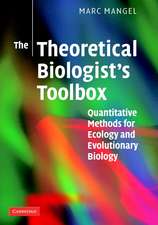The Mechanistic Benefits of Microbial Symbionts: Advances in Environmental Microbiology, cartea 2
Editat de Christon J. Hursten Limba Engleză Hardback – 2 iun 2016
| Toate formatele și edițiile | Preț | Express |
|---|---|---|
| Paperback (1) | 945.92 lei 6-8 săpt. | |
| Springer International Publishing – 30 mai 2018 | 945.92 lei 6-8 săpt. | |
| Hardback (1) | 952.09 lei 6-8 săpt. | |
| Springer International Publishing – 2 iun 2016 | 952.09 lei 6-8 săpt. |
Preț: 952.09 lei
Preț vechi: 1161.08 lei
-18% Nou
Puncte Express: 1428
Preț estimativ în valută:
182.20€ • 190.46$ • 153.96£
182.20€ • 190.46$ • 153.96£
Carte tipărită la comandă
Livrare economică 06-20 martie
Preluare comenzi: 021 569.72.76
Specificații
ISBN-13: 9783319280660
ISBN-10: 331928066X
Pagini: 300
Ilustrații: XII, 315 p. 47 illus., 24 illus. in color.
Dimensiuni: 155 x 235 x 19 mm
Greutate: 0.64 kg
Ediția:1st ed. 2016
Editura: Springer International Publishing
Colecția Springer
Seria Advances in Environmental Microbiology
Locul publicării:Cham, Switzerland
ISBN-10: 331928066X
Pagini: 300
Ilustrații: XII, 315 p. 47 illus., 24 illus. in color.
Dimensiuni: 155 x 235 x 19 mm
Greutate: 0.64 kg
Ediția:1st ed. 2016
Editura: Springer International Publishing
Colecția Springer
Seria Advances in Environmental Microbiology
Locul publicării:Cham, Switzerland
Public țintă
ResearchCuprins
Symbiotic associations: all about chemistry.- Phage conversion and the role of bacteriophage and host functions in regulation of diphtheria toxin production by Corynebacterium diphtheriae.- Syntrophic growth of Symbiobacterium in association with free-living bacteria.- The mechanism of symbiotic nitrogen fixation.- Antimicrobials and the natural biology of a bacterial-nematode symbiosis.- The role of symbionts in the evolution of termites and their rise to ecological dominance in the tropics.- Diverse bacteriophage roles in an aphid-bacterial defensive mutualism.- Symbiotic Streptomyces provide antifungal defense in solitary wasps.- Watersipora subtorquata and the possible role of its associated microbes – an attempt to explain the extraordinary invasion success of this marine bryozoan species.- Animal-Symbiodinium symbioses: foundations of coral reef ecosystems.-Fiat lux: the squid-vibrio association as a model for understanding host-microbe associations.
Textul de pe ultima copertă
This volume summarizes recent advances in our understanding of the mechanisms that produce successful symbiotic partnerships involving microorganisms. It begins with a basic introduction to the nature of and mechanistic benefits derived from symbiotic associations. Taking that background knowledge as the starting point, the next sections include chapters that examine representative examples of coevolutionary associations that have developed between species of microbes, as well as associations between microbes and plants. The authors conclude with a section covering a broad range of associations between microbes and invertebrate animals, in which they discuss the spectrum of hosts, with examples ranging from bryozoans and corals to nematodes, arthropods, and cephalopods. Join the authors on this journey of understanding!
Caracteristici
Enables readers to understand the types of interactive mechanisms that have resulted in evolutionary success Written by eminent scientists Richly illustrated throughout Includes supplementary material: sn.pub/extras























